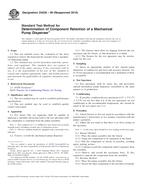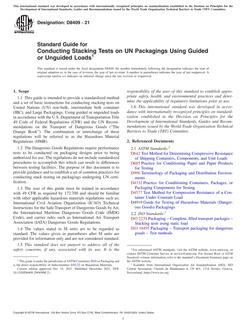1.1 This test method provides procedures for measuring the leach rates of elements from a solidified matrix material, determining if the releases are controlled by mass diffusion, computing values of diffusion constants based on models, and verifying projected long-term diffusive releases. This test method is applicable to any material that does not degrade or deform during the test.
1.1.1 If mass diffusion is the dominant step in the leaching mechanism, then the results of this test can be used to calculate diffusion coefficients using mathematical diffusion models. A computer program developed for that purpose is available as a companion to this test method (Note 1).
1.1.2 It should be verified that leaching is controlled by diffusion by a means other than analysis of the leach test solution data. Analysis of concentration profiles of species of interest near the surface of the solid waste form after the test is recommended for this purpose.
1.1.3 Potential effects of partitioning on the test results can be identified through modeling, although further testing and analyses are required to determine the cause of partitioning (for example, if it occurs during production of the material or as a result of leaching).
1.2 The method is a modification of other semi-dynamic tests such as the IAEA test (1) and the ANS 16.1 Leach Test wherein elevated temperatures are used to accelerate diffusive release to an extent that would only be reached after very long times at lower temperatures. This approach provides a mechanistic basis for calculating diffusive releases at repository-relevant temperatures over long times, provided that the leaching mechanism does not change with temperature.
1.2.1 Tests can be conducted at elevated temperatures to accelerate diffusive release and provide a mechanistic basis for calculating diffusive releases that would occur at lower temperatures over long times. Tests conducted at high temperatures allow the temperature dependence of the diffusion coefficient to be determined. They also demonstrate that the diffusion mechanism is rate-limiting through the measured extent of diffusive release.
1.2.2 Releases at any temperature can be projected up to the highest cumulative fractional release value that has been measured for that material (at any temperature), provided that the mechanism does not change. The mechanism is considered to remain unchanged over a range of temperatures if the diffusion coefficients show Arrhenius behavior over that range.
Note 1 – A computer program in which the test results are evaluated using three diffusion models is briefly described in Annex A1 and in the Accelerated Leach Test Method and User’s Guide for the “ALT“ Computer Program (2). The data are fit with model equations for diffusion from a semi-infinite solid, diffusion from a finite cylinder, and diffusion with partitioning of the species of interest to determine effective diffusion coefficients and quantify the goodness of fit. The User's Guide contains several typographical errors; these are identified in Annex A1.
1.3 The values stated in SI units are to be regarded as standard. No other units of measurement are included in this standard.
1.4 This standard does not purport to address all of the safety concerns, if any, associated with its use. It is the responsibility of the user of this standard to establish appropriate safety and health practices and determine the applicability of regulatory limitations prior to use.
Product Details
- Published:
- 12/01/2008
- Number of Pages:
- 14
- File Size:
- 1 file , 190 KB
- Redline File Size:
- 2 files , 380 KB


